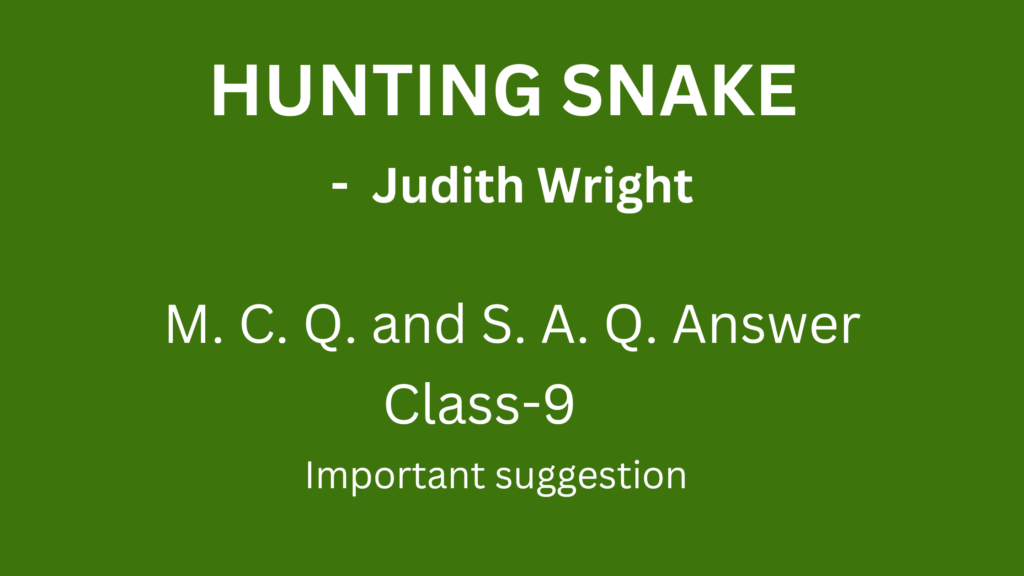
About the Poet:
Judith Wright was born in Armidale, New South Wales, the eldest child of Philip Wright and his first wife Ethel. After the early death of her mother, she lived with her aunt and then boarded at New England Girls’ school. After graduating, Wright studied Philosophy, English, psychology and History at the University of Sydney. At the beginning of the World War II, she returned to her father’s station to help him during the shortage of labor caused by the war.
Wright’s first book of poetry, The Moving Image, was published in 1946. She was the second Australian to receive the ‘Queen’s Gold Medal’ for poetry, in 1991. She started to lose her hearing in her mid-20s and became completely deaf by 1992. She died on June 25, 2000, in Canberra, Australian Capital Territory.
About the Poetry:
On the surface, ‘Hunting Snake’ appears to describe a simple experience of a group of people coming across a snake, while walking. The first stanza depicts a group walking through a forest, when they stop to watch a snake go past. The second stanza describes the snake’s beauty. The third stanza describes the power of the snake as a predator. It is somehow fearsome to others because of its fierce intent. In the final stanza the snake disappears and the men of the group look at each other and then continue walking.
In deeper level, it can serve some symbolical purpose. On our earth, reality and mystery live side by side. We are the reality, the snake is also the same, but somehow they are also mysterious, creating awe and wonder among us. We watch them but from a distance. They are black, furious again generous and splendid.
Also read: (M.C.Q.) Answers From “MILD THE MIST UPON THE HILL” | Class-9
HUNTING SNAKE
– JUDITH WRIGHT
Tick (✓) the correct answer from the given alternatives:
1) The poet was sun-warmed under the gentlest sky of –
A) summer
B) winter
C) autumn ✓
D) spring
2) The colour of the snake was –
A) black ✓
B) grey
C) green
D) yellow
3) The tongue of the snake was –
A) still
B) flickering ✓
C) hanging
D) dangling
4) The shape of the snake’s scale was like –
A) star
B) kite
C) diamond ✓
D) pyramid
5) The snake was moving along –
A) a metalled road
B) an unmetalled road
C) a grassy land ✓
D) a bushy land
6) The poet and her companions froze because of –
A) cold weather
B) cold autumn morning
C) fear ✓
D) tension
7) Seeing the snake the poet and her companion –
A) fled away
B) left the place very slowly
C) started walking speedily
D) stood motionless ✓
8) According to the poet, the intent of the snake was –
A) malicious
B) greedy
C) timid
D) fierce ✓
9) The Snake finally disappeared into the –
A) sand
B) grass ✓
C) rock
D) stream
10) The snake was searching in the grass –
A) some friends
B) small food ✓
C) some shelter
D) sun’s warmth
11) The poet personifies the autumn day as –
A) cruel
B) having a lot of grace ✓
C) soft
D) loving mother
12) The snake was moving in a –
A) circular motion
B) straight-way
C) dancing movement
D) reeling motion ✓
13) The snake was –
A) standing still
B) slithering ✓
C) sleeping
D) hibernation
14) In the poem the word ‘trail’ means –
A) path ✓
B) alley
C) grass
D) sand
15) In the poem ‘he’ refers to –
A) pet dog of the poet
B) cat of the poet
C) a lion
D) a snake ✓
16) “And we lost breath to see him pass” – Here ‘we lost’ means –
A) we died
B) we breathed quickly
C) our breath was arrested ✓
D) we could not find our breath
17) When the poet and her companions saw the snake, it was –
A) daytime ✓
B) dawn
C) dusk
D) night
18) The poet and her companions were much _________ to see the snake.
A) delighted
B) excited
C) frightened
D) wonder-struck ✓
Questions and Answers (S. A. Q):
Answer the following questions within twenty – five words:
1) How did the snake appear as it was moving through the grass?
Ans- As the snake was moving through the grass, its head was down and tongue flickering. With sunlight on it, the scales glazed like diamonds.
2) What did the poet and her companions do when the snake was gone?
Ans- When the snake was gone, the poet and her companions took a deeper breath. They looked at each other and went on their own way.
3) “We lost breath…..” – Why?
Ans- The poet and her companions lost their breath for sometime, watching the black, splendid and awe inspiring beauty of the snake.
4) Watching the black snake, what did the poet and her companions forget to think?
Ans- The poet and her companions forgot to think what the track of the snake was, and what small food fled living from his fierce intent.
5) What was the initial reation of the poet and her companions seeing the snake?
Ans- Seeing the snake the poet and her companion stood motionless.